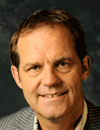Co-Located Conference AgendasAdvances in Biodetection and Biosensors | Advances in Microarray Technology | Lab-on-a-Chip European Congress | Single Cell Analysis Europe | 

Wednesday, 28 March 201208:00 | Registration | |
Microfluidicist's Toolbox of Forces |
| | 09:00 | Advancing Microchip Acoustophoretic Cell Handling in Life Science Applications
Johan Nilsson, Associate Professor, Lund University, Sweden
Recent advances in microchip acoustophoresis will be outlined, demonstrating tumor cell extraction and strategies to concentration and enrichment of biological species.
| 09:30 | Attraction and Repulsion – Magnetic Forces for Particle and Cell Handling
Nicole Pamme, Professor in Analytical Chemistry, Stockholm University, Sweden
Microfluidic devices are presented for the trapping, focussing and deflection of particles and cells based on magnetic attraction and repulsion forces. | 10:00 | Dielectrophoretic Manipulation of Cells for Biomedical Applications
Claus Duschl, Head, Fraunhofer Institute for Biomedical Engineering, Germany
High-frequency electromagnetic fields in microfluidic systems are utilised (i) for the production of hybrid cells through the fusion of defined cell pairs and, (ii) for the characterization of the mechanical properties of cells for diagnostic purposes. | 10:30 | Coffee Break & Networking in Exhibition Hall | |
Market Orientated Device Development |
| | 11:15 | Assay Miniaturization Based on Centrifugal Microfluidics
Roland Zengerle, Professor, University of Freiburg, Germany
Centrifugal microfluidics enables sequential combination of microfluidic unit operations such as reagent storage and release, extraction of certain molecular species from complex samples, metering, mixing, incubation, enrichment and/or amplification on a low-cost substrate. We demonstrate this by implementing various assays in molecular diagnostics. | 11:45 | Microelectronics Meets Microfluidics: Integrated Sensors in Microfluidic Devices
Holger Becker, Chief Scientific Officer, Microfluidic ChipShop GmbH, Germany
In addition to the well established optical detection methods, a recent development in lab-on-a-chip technology is the increased use of sensor technology for the detection of analytes in a microfluidic system. These sensors can range from relatively simple electrochemical sensors to electronically read-out microarrays or highly integrated nano-electrode sensors with on-chip signal processing capabilities. These sensors require innovative technological solutions for their integration into a microfluidic cartridge. We will present solutions for such integrated systems for the detection of biomarkers, proteins and nucleic acids for applications in rapid infectious disease identification or drug efficacy monitoring. | 12:15 |  Technology Spotlight: Technology Spotlight:
Industrialization & Economics of Smart Consumables in Life Sciences & Diagnostics
Philip Perry, Manager, Sony DADC
Smart Consumables with microstructures / microfluidic features and functionalised surfaces are prerequisites for emerging applications in the Life Sciences and in-vitro Diagnostics (IVD) markets. The increasing complexity of such new products in those markets requires new manufacturing technologies. Sony DADC is now applying its excellence in customised mass manufacturing and its efficient processes to these highly sophisticated consumables in its new OEM business in a B2B format with leading, innovative companies in the biomedical field.
| 12:30 | Lunch & Networking in Exhibition Hall | 13:30 | Poster Viewing Session | 14:15 | Lab-on-a-Chip Technology for Diagnostic Applications – From the Research Lab to Real Products
Jaap den Toonder, Chief Scientist, Philips Research Laboratories, Netherlands
We are entering a phase in which commercial companies are adapting lab-on-a-chip technologies to develop real products. In this lecture I will show examples of such products we are currently developing: a handheld biosensor for immunoassays that can be used for magnetic or optical detection of drugs of abuse (DOA) in saliva, or cardiac markers (e.g. troponin) in blood, and cell-diagnostics applications. I will talk about the principles, (dis)advantages, and critical aspects for commercialization. | 14:45 | Microfluidic Devices Market. Materials,Market and Trends
Frederic Breussin, Business Unit Manager, Yole Developpement, France
This paper provides data on the microfluidic device market, with a special focus on materials, manufacturing processes and production costs. | 15:15 |  Technology Spotlight: Technology Spotlight:
Bonding Your Future
Ray Karam, President and CEO, Invenios
| 15:30 | Coffee Break & Networking in Exhibition Hall | |
Nanotech on a Chip |
| | 16:00 | Nanopore Sensors for Next Generation DNA Sequencing
Joshua Edel, Professor, Imperial College London, United Kingdom
We report on the fabrication and characterization of a DNA nanopore detector with integrated tunnelling electrodes for use as a possible route to high throughput DNA sequencing. | 16:30 | Enhancing the Capture of DNAs into Nanochannels via Engineering Nanochannel Inlets
Sunggook Park, Associate Professor, Louisiana State University, United States of America
One challenge in operating the nanochannel device is the difficulty in threading DNA molecules from microfluidic networks into small nanochannels electrophoretically. In this presentation, strategies to overcome this challenge by engineering nanochannel inlet structures will be shown. | 17:00 |  | Keynote Presentation Labs-on-a-Chip for Medical Applications
Albert Van Den Berg, Professor, University Of Twente, Netherlands
The recent rapid developments in microfluidics technologies has enabled the realization of miniaturized laboratories. These Labs-on-a-Chip will play an important role in future medicine, both in point-of-care devices for drug or biomarker monitoring, as well as in early diagnostic devices. We developed a pre-filled ready-to-use capillary electrophoresis platform for measuring ions in blood. It is used to monitor lithium in finger-prick blood of manic-depressive patients, but can also be used for measuring calcium in blood for prevention of milk fever, or for measuring creatinine in blood or sodium in urine for early detection of ESRD. Another device was developed for analyzing male fertility by determining sperm concentration and motility in semen. It appears that the same device can be easily adapted to detect the presence of cells in milk, a good indicator for the presence of mastitis.For early detection of colon cancer, nanowire sensors for detection of hypermethylated DNA will be presented, showing label-free DNA detection. The small size of these nanowire sensors enables the integration of a complete lab in a pill, that may be used as a screwening tool for early diagnostics of intestinal cancer. |
| 17:30 | Drinks Reception |
Thursday, 29 March 2012 |
Diagnostics & Medical Applications |
| | 09:00 | Materials and Manufacturing of Labs-on-Chip for Infectious Diseases
Wouter van der Wijngaart, Professor, KTH Royal Institute of Technology, Sweden
Presentation of the novel off-stoichiometry thiol-ene (OSTE) polymer system and its application as a microfluidic packaging material in lab-on-chip devices for detection of pathogens and their antibiotic susceptibility. | 09:30 | On-Site Blood Preparation Unit
Manuel Kemmler, Scientific Associate, Fraunhofer Institute for Physical Measurement Techniques, Germany
The presented blood preparation unit is developed for an on-site usage and comprises a disposable low-cost chip with simple fluidic structures. The plasma is separated from the blood cells axial to the channels by the use of haemagglutinins and hydrodynamic effects. | 10:00 |  | Keynote Presentation New Optical, Acoustic and Electrical Technologies for Developing World Diagnostics
Jon Cooper, Professor, University of Glasgow, United Kingdom
Infectious diseases cause 10 million deaths each year worldwide, accounting for ~60% of all deaths of children aged 5-14. Although these deaths arise primarily through pneumonia, TB, malaria and HIV, there are also the so called “neglected diseases” such as sleeping sickness and bilharzia, which have a devastating impact on rural communities, in sub-Sahara Africa. Here, the demands for a successful Developing World diagnostic are particularly rigorous, requiring low cost instrumentation with low power consumption (there is often no fixed power infrastructure). In many cases, the levels of infection within individuals are also sufficiently low that instruments must show extra-ordinary sensitivity, with measurements being made in blood or saliva. In this talk, a description of these demands will be given, together with a review of some of the solutions that have been developed, which include using acoustics, optics and electrotechnologies, and their combinations to manipulate the fluid sample. In one example, we show how to find a single trypanosome, as the causative agent of sleeping sickness, amongst a background of over 100 million bloods cells. |
| 10:30 | Coffee Break & Networking in Exhibition Hall | |
Biological Analysis |
| | 11:15 | Isolation of Factors Involved in Stem Cell to Adipocyte Conversion is Enabled by Microfluidic Cell Culture Techniques
Martin Dufva, Associate Professor, Technical University of Denmark, Denmark
Microfluidic perfusion showed that an adipocyte secreted factor and availability of nutrient building blocks affects stem cell derived adipocyte development.
| 11:45 | Single Cells in the Spotlight: Detection of Heterogeneous Cell Response
Petra Dittrich, Assistant Professor, ETH Zurich, Switzerland
In this presentation, various approaches to single cell analysis on microfluidic platforms are presented that allow single cell gene expression studies, single cell electrophysiology and single cell toxicity tests. | 12:15 |  Technology Spotlight: Technology Spotlight:
Novel Biochip and Reagents for High specificity nucleic acid detections
Salvatore Pernagallo, Product Development Manager, DestiNA Genomics Ltd
DestiNA Genomics Ltd has developed a revolutionary chemistry-based technology with massive global potential in multiple markets, including the medical, veterinary, food, agricultural and forensic sectors.
This presentation will describe existing performance of DestiNA’s reagents with Lab-on-a-Chip molecular diagnostics platform.
| 12:30 | Lunch & Networking in Exhibition Hall | 13:15 | Poster Viewing Session | 14:00 | Photonic Lab on a Chip for Life Science Applications
Andreu Llobera, Researcher, Institut de Microelectronica de Barcelona, Spain
Photonics applied to life sciences has become popular for cell screening, mainly because of its speed and non-invasiveness. Lab-on-a-chip with photonic readout allows obtaining systems with outstanding performance. The latest achievements will be presented in this talk. | |
Manipulation & Detection |
| | 14:30 | Photo-Actuation of Macro- and Microfluidic Systems
Damien Baigl, Professor, Ecole Normale Superieure, France
We show that photocontrol of interfacial energy allows us to generate and manipulate microscopic (10-100 µm) and macroscopic (~mm) droplets using light, with high spatio-temporal resolution and applicability to a large variety of fluidic systems. | 15:00 | Coffee Break & Networking in Exhibition Hall | 16:00 | Label-Free Detection of Protein in a Microfluidic Device Using Bead-Based Electrical Impedance Spectroscopy
Romen Rodriguez-Trujillo, Postdoctoral Researcher, Technical University of Denmark (DTU), Denmark
A new method for label-free detection of proteins in a microfluidic device by using bead-based Electrical Impedance Spectroscopy has been developed. The direct electrical readout mechanism is simple and potentially allows implementing the assays for point of care diagnosis. | 16:30 | Close of Conference |
|


 Add to Calendar ▼2012-03-28 00:00:002012-03-29 00:00:00Europe/LondonLab-on-a-Chip European CongressLab-on-a-Chip European Congress in Edinburgh, ScotlandEdinburgh, ScotlandSELECTBIOenquiries@selectbiosciences.com
Add to Calendar ▼2012-03-28 00:00:002012-03-29 00:00:00Europe/LondonLab-on-a-Chip European CongressLab-on-a-Chip European Congress in Edinburgh, ScotlandEdinburgh, ScotlandSELECTBIOenquiries@selectbiosciences.com